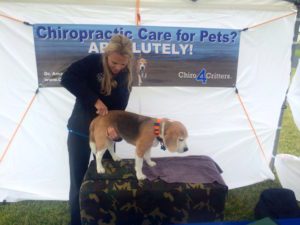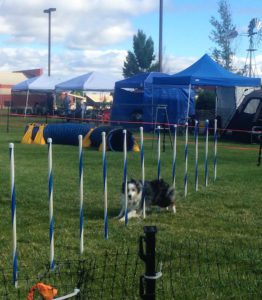Canine agility owners love their dogs and take excellent care of them. If you want to see a truly happy dog having a blast, come check out an agility trial. It’s actually quite fun to watch! I won’t go into the specifics of agility, but I will say that it is a sport that is highly demanding on a dog’s body, especially when it’s done repetitively. There are varying obstacles that the dogs need to maneuver, (i.e., jumps, contact obstacles, tunnels, weaves), but jumping is the basis of all agility. The goal of the competition is: 1) Have fun with your dog and 2) Do the best you can on the course to qualify to earn titles. Every performance in agility is dependent the confirmation of the dog, training, and the handling at that moment.
having a blast, come check out an agility trial. It’s actually quite fun to watch! I won’t go into the specifics of agility, but I will say that it is a sport that is highly demanding on a dog’s body, especially when it’s done repetitively. There are varying obstacles that the dogs need to maneuver, (i.e., jumps, contact obstacles, tunnels, weaves), but jumping is the basis of all agility. The goal of the competition is: 1) Have fun with your dog and 2) Do the best you can on the course to qualify to earn titles. Every performance in agility is dependent the confirmation of the dog, training, and the handling at that moment.
There are only a few studies (more like surveys) that identified the most common areas injured on an agility dog. After working on tons of agility dogs over the years, I don’t need a study to tell me which areas are most commonly injured. The back and the shoulders are most commonly injured based on my experience as an animal chiropractor. Other common injuries: iliopsoas strain, anterior cruciate ligament tear/rupture, achilles tendon tears.
The pelvic limbs (hind legs) are long and angular, heavily muscled and connected to the lower spine. They
 are designed for propulsion. The thoracic limbs (front legs) are shorter, straighter, and connected to the trunk by fibro-muscular attachments. They are designed for support. Under certain circumstances, they provide upward propulsion and directional stability. The center of gravity is pivotal in allowing the dog to increase speed as well as going up and down hills.
are designed for propulsion. The thoracic limbs (front legs) are shorter, straighter, and connected to the trunk by fibro-muscular attachments. They are designed for support. Under certain circumstances, they provide upward propulsion and directional stability. The center of gravity is pivotal in allowing the dog to increase speed as well as going up and down hills.
Even a well-trained and conditioned dog can get injured if their biomechanics are off due to a single bone out of alignment in their spine or extremity joints. Agility dog owners are very in-tune with their dog and notice immediately when their dog “seems a bit off”. Whether they are knocking bars or seem to be running a bit slower than usual, getting checked out by an Animal Chiropractor is a good idea, especially if you plan on running them again that same trial. In my experience, I find that the well-conditioned agility dog responds very well to chiropractic care, and enjoys the hands-on experience. Keeping these athletes on a chiropractic maintenance plan is crucial in keeping them in top shape.
While my practice is primarily based out of a veterinary clinic, I can often be found at local agility trials keeping the canine athletes mobile, healthy and happy. Agility dog owners are some of the kindest, most big-hearted people I know. Many, having multiple dogs, take excellent care of each and every one of them. Agility dog injuries and chiropractic is something I take seriously and I hope to meet your furry athlete someday.
If you are curious as to what the agility trails are all about, check out a local trial near you. If you are local to the Vancouver Washington or Portland Oregon areas, a list of trials I will be at are posted on my site:
https://www.chiro4critters.com/animal-chiropractic-events/


Recent Comments